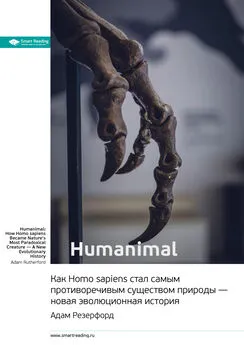Джек Палмер - Эволюционная психология. Секреты поведения Homo sapiens
- Название:Эволюционная психология. Секреты поведения Homo sapiens
- Автор:
- Жанр:
- Издательство:Прайм-Еврознак
- Год:2003
- Город:Санкт-Петербург
- ISBN:5-93878-094-2
- Рейтинг:
- Избранное:Добавить в избранное
-
Отзывы:
-
Ваша оценка:
Джек Палмер - Эволюционная психология. Секреты поведения Homo sapiens краткое содержание
Эволюционно-психологический подход, освоенный вами с помощью этого издания, позволит понять и объяснить самые глубокие феномены человеческого поведения: любовь и ревность, гневливость и сострадание, дружбу и агрессивность, лидерство и альтруизм. Эволюционная психология — современная научная дисциплина, изучающая адаптивное значение поведения человека в самых разных социальных контекстах. Основными темами книги являются: происхождение человека; эволюция человеческого мозга, сознания и языка; брачное, сексуальное, социальное и экономическое поведение; истоки орудийной деятельности и искусства.
Эта книга — уникальный источник информации для широкого круга современных биологов, психологов, социологов и экономистов.
Эволюционная психология. Секреты поведения Homo sapiens - читать онлайн бесплатно полную версию (весь текст целиком)
Интервал:
Закладка:
Kant, I. (1927). Kant's inaugural dissertation and early writings on space. Westport, CT: Hyper-ion Press, Inc.
Kaplin, S. (1992). Environmental preference in a knowledge-seeking, knowledge-using organism. In J. Barkow, L. Cosmides, & J. Tooby (Eds.), The adapted mind. New York: Oxford University Press.
Keil, F. C. (1989). Concepts, kinds and cognitive development. Cambridge, MA: MIT Press.
Kimble, J. W. (1994). Biology (6th ed.). Oxford: Wm. C. Brown Publishers.
Klaus, M. H., & KennellJ. H. (1976). Maternal-infant bonding (2nd ed.). St. Louis, MO: Mosby.
Klima, B. (1990). Chronologie de Fart mobilier paleolithique en Europe centrale. In J. Clottes (Ed.), L'artdesobjetsaupaleolithicfue(Vol. l,pp. 133–141). Foix: French Ministry of Culture.
Kohler, W. (1976). The mentality of apes (E. Winter, Trans., Rev. ed.). New York: Liveright. (Original work published 1927)
Kramer, P. (1993). Listening to Prozac. New York: Viking Press.
Kuhl, P. (2001). Speech, language and developmental change. In F. Lacerda, C. von Hof-sten, et al. (Eds.), Emerging cognitive abilities in early infancy. Mahwah, NJ: Eribaum.
Leakey M. G., & Harris, J. M. (1987). Laetoli: A Pliocene site in northern Tanzania. New York: Oxford University Press.
Leakey, R. (1981). The making of mankind. New York: Dutton.
Leakey, R. (1994). The origin of humankind. New-York: Basic Books.
Leakey, R., & Lewin, R. (1992). Origins reconsidered: In search of what makes us human. New York: Doubleday.
Lenneberg, E. H. (1967). Biological foundations of language. New York: Wiley.
LeVay, S. (1993). The sexual brain. Cambridge, MA: MIT Press.
Levy.J., & Heller, W. (1992). Gender differences in human neuropsychological function. In A. A. Gerall, H. Moltz, & I. L. Ward (Eds.), Handbook of behavioral neurobiology. New York & London: Plenum Press.
Loehlin, J. (1992). Genes and environment in personality development: Sage series on individual
differences and development (Vol. 2). Newbury Park, CA: Sage Publications, Inc.
Lorenz,K.Z.(1965). Behind themirror.NewYorkand London: Harcourt BraceJovanovich.
Maccoby E. E. (1998). The two sexes: Growing up apart, coming together. Cambridge, MA: The Belknap Press of Harvard University Press.
Machiavelli, N. (1532). The Prince. New York: Norton.
Maier, R. A. (1998). Comparative animal behavior An evolutionary and ecological approach. Chicago: Allyn and Bacon.
Marano, H. E. (1999). Depression: Beyond serotonin. In B. M. Jubilan (Ed.), Biopsychology (5th ed.). Guilford, CT: Dushkin/McGraw-Hill.
Markovitz, P. (1995). Pharmacotherapy of impul-sivity, aggression, and related disorders. In E. Hollander & D. Stein (Eds.), Impulsivity and aggression. West Sussex, England: John Wiley & Sons.
Marks, I. M. (1987). Fears, phobias, and rituals. New York: Oxford University Press.
Marino, L, Reiss, D., & Galiup, G. G., Jr. (1994). Mirror self-recognition in bottlenose dolphins: Implications for comparative investigations of highly dissimilar species. In S. T. Parker, R. W. Mitchell, & M. L. Boccia (Eds.), Self-awareness in animals and humans: Developmental perspectives. New York: Cambridge University Press.
Marten, D., & Psarakos, S. (1994). Evidence of self-awareness in the bottlenose dolphin (Tursiops truncatus). In S. T. Parker, R. W. Mitchell, & M. L. Boccia (Eds.), Self-awareness in animals and humans: Developmental perspectives. New York: Cambridge University Press.
McGuire, M. Т., & Troisi.A. (1998). Darwinian psychiatry. New York: Oxford University Press.
Mealy, L. (1993). Selective memory for faces of cheaters? Presented at the Evolution and Human Science conference, London.
Meyer, R. G., & Deitsch, S. E., (1996). The clinician's handbook: Integrated diagnostics, assessment, and intervention in adult and adolescent psychopathology (4th ed.). Boston: Allyn and Bacon.
Miller, G. F. (1995). Darwinian demographics of cultural production. Paper presented at the Human Behavior and Evolution Society 7th annual meeting. University of California, Santa Barbara.
Miller, G. F. (1998). How mate choice shaped human nature: A review of sexual selection and human evolution. In C. Crawford & D. L. Krebs (Eds.), Handbook of evolutionary psychology: Ideas, issues, and applications. Mah-wah, NJ: Eribaum.
Milner, R. (1990). The encyclopedia of evolution: Humanity's searchfor its origins. New York: Facts on File.
Mitchell, P. (1997). Introduction to theory of mind: Children, autism, and apes. New York: Arnold.
Morris, D. (1967). The naked ape. New York: Dell.
Newport, E. (1986, November). Maturational constraints on language learning. Paper presented at the meeting of the Psychonomic Society, New Orleans.
Newport, E., & Supalla, T. (In press). A critical period effect in the acquisition of primary language. Science.
Notman, M. T, & Nadelson, С. С., (1990). Women and men: New perspectives on gender differences. Washington, DC: American Psychiatric Press, Inc.
Orians, G. Н., & Heerwagen, J. Н. (1992). Evolved responses to landscapes. In J. Barkow, L. Cosmides, & J. Tooby (Eds.), The adapted mind. New York: Oxford University Press.
Palmer,], McCown, W, & Kerby, D. (1997). The adaptive significance of «dysfunctional impulsiv-ity.» Presented at the Human Behavior and Evolution Society conference, Tucson, AZ.
Palmer, J., McCown, W., & Thornburgh, T. (1998). The ontogenetic priming of social hierarchical functioning. Presented at the International Society for Human Ethology conference, Victoria, ВС.
Patterson, R, & Cohn, R. H. (1994). Self-recognition and self-awareness in lowland gorillas. In S. T. Parker, R. W Mitchell, & M. L. Boccia (Eds.), Self-awareness in animals and humans: Developmental perspectives. New York: Cambridge University Press.
Pepperberg, I. M. (1993). Cognition and communication in an African Grey parrot (Psittacus erithacus): Studies on a nonhuman, nonpri-mate, nonmammalian subject. In H. L. Roit-blat, L. M. Herman, & P. Nachtigall (Eds.). Language and communication: Comparative perspectives. Comparative cognition and neuro-science (pp. 221–248). Hillsdale, NJ: Eribaum.
Pepperberg, I. M. (1996). Categorical class formation by an African Grey parrot (Psittacus erithacus). In T. R. Zentell & P. M. Smeets (Eds.), Stimulus class formation in humans and animals. Advances in psychology (No. 17, pp. 71–91). Amsterdam, Netherlands: Else-vier Science Publishing Co., Inc.
Pinker, S. (1994). The language instinct. New York: Harper Collins.
Pinker, S. (1997). How the mind works. New York: Norton.
Poizner, H., Klima, E. S., & Bellugi, U. (1987). What the hands reveal about the brain. Cambridge, MA: MIT Press.
Premack, D. (1971). On the assessment of language competence in the chimpanzee. In A. M. Schrier & F. Stollnitz (Eds.), Behavior of nonhuman primates (Vol. 4). New York: Academic Press.
Prentice, A. M., & Whitehead, R. G. (1987). The energetics of human reproduction. In A. S. I. Loudon & P. A. Racey (Eds.), Reproductive energetics in mammals. Oxford: Clarendon Press.
Preuss, T. M. (2000). Evolution. In M. S. Gaz-zaniga (Ed.), The New Cognitive Neurosciences. Cambridge, MA: MIT Press.
Prochaska, J., & Norcross, J, (1994). Systems a/ psychotherapy: A transtheoretical analysis, (3rd ed.). Pacific Grove, CA: Brooks/Cole Publishing.
Profet, M. (1992). Pregnancy sickness as adaptation: A deterrent to maternal ingestion of ter-atogens. In J. Barkow, L. Cosmides, & J. Tooby (Eds.), The adapted mind. New York: Oxford University Press.
Reddy, V, Hay, D., Murray, L., & Trevarthen, C. (1997). Communication in infancy: Mutual regulation of affect and attention. In G. Bremner, A. Slater, et al. (Eds.), Infant development: Recent advances. Hove, England: Psychology Press/Erlbaum.
Ridley M. (1996). The Origins of Virtue. New York: Viking.
Ross, C, & Garaett, S. (Eds.). (1989). Crocodiles and alligators. New York Facts on File.
Rottschaefer, W. (1998). The biology and psychology of moral agency. New York: Cambridge University Press.
Rozin, P. (1976). Psychological and cultural determinants of food choice. In T. Silverstone (Ed.), Appetite and food intake. Berlin: Dahlem Konferenzen.
Rymer, R. (1993). Genie: An abused child's flight from silence. New York: HarperCollins.
Salter, E K. (1998). Indoctrinationas institutionalized persuasion: Its limited variability and cross-cultural evolutioa In I. Eible-Eibesfeldt, & E K. Salter, (Eds.), Indoctrinabil-ity, ideology, and warfare: Evolutionary perspectives. New York: Berghahn Books.
Sapolsky, R. M., (1997). Stress in the wild. In R. W. Sussman (Ed.), The biological basis of human behavior. Needham Heights, MA: Simon & Schuster Custom Publishing.
Sapolsky, R. M. (1999). Why stress is bad for your brain. In B. M. Jubilan (Ed.), Biopsychology (5th ed.). Guilford, CT: Dushkin/McGraw-Hill.
Sarich, V. M. (1983). A personal perspective on hominoid macromolecular systematics. In R. L. Ciochon and R. S. Corruccini (Eds.), New interpretations of ape and human ancestry. New York: Plenum Press.
Savage-Rumbaugh, S., Shanker, S. G, & Taylor, T. J. (1998). Apes, language, and the human mind. New York: Oxford University Press.
Schick, K. D., & Toth, N. (1993). Making silent stones speak. New York: Simon & Schuster.
Schiller, P. H. (1957). Innate motor action as a basis of learning. In C. Schiller (Ed.), Instinctive Behavior. New York: International Universities Press.
Selye, H. (1956). The stress of life. New York: Mc-Graw Hill.
Sheehy, N., Chapman, A., & Conroy, W. (1997). Biographical dictionary of psychology. London: Routledge.
Sherman, P. (1980). The limits of ground squirrels nepotism. In Barlow, G., & Silverberg, J. (Eds.), Sociobiology: Beyond nature/nurture? Boulder, CO: Westview Press.
Silver-man, I., & Eals, M. (1992). Sex differences in spatial abilities: Evolutionary theory and data. In J. Barkow, L. Cosmides, & J. Tooby (Eds.), The adapted mind. New York: Oxford University Press.
Slater, A., & Johnson, S. (1998). Visual sensory and perceptual abilities of the newborn: Beyond the blooming, buzzing confusion. In R Simion, G. Butterworth.etal. (Eds), The development of sensory, motor and cognitive capacities in early infancy: From perception to cognition. Hove, England: Psychology Press/ Eribaum.
Smith, E. (1988). Risk and uncertainty in the 'original affluent society.' In T. Ingold, D. Riches, & J. Woodburn, (Eds.), Hunters and gatherers: Vol. 1. History, evolution, and social change. Oxford: Berg.
Smith, E. 0. (1999). Evolution, substance abuse, and addiction. In W. R. Trevathan, E. 0. Smith, & J. J. Mckenna (Eds.), Evolutionary medicine. New York: Oxford University Press.
SmithJ.M.(1982).Evolutionand the theory ofgames. Cambridge, England: Cambridge University Press.
Smuts, В. В., Cheney, D. L., Seyfarth, R. M., Wrangham, R. W, & Struhsaker, Т. Т. (Eds.), (1987). Primate societies. Chicago: University of Chicago Press.
Sober, E. (1994). From a biological point of view: Essays on evolutionary philosophy. New York: Cambridge University Press.
Speike, E. S. (1998). Where perceiving ends and thinking begins: The apprehension of objects in infancy. In A. Yonas, et al. (Eds.), Perceptual development in infancy. The Minnesota symposia on child psychology, Vol. 20. Hillsdale, NJ: Eribaum.
Spiro, M. E. (1958). Children of the kibbutz. Cambridge, MA: Harvard University Press.
Stevens, A., & Price, J. (1996). Evolutionary psychiatry: A new beginning. London: Routledge.
Strickberger, M. W. (1990). Evolution. Boston: Jones and Bartlett Publishers.
Sulloway, F. J. (1996). Born to rebel: Birth order, family dynamics, and creative lives. New York: Pantheon Books.
Читать дальшеИнтервал:
Закладка:









